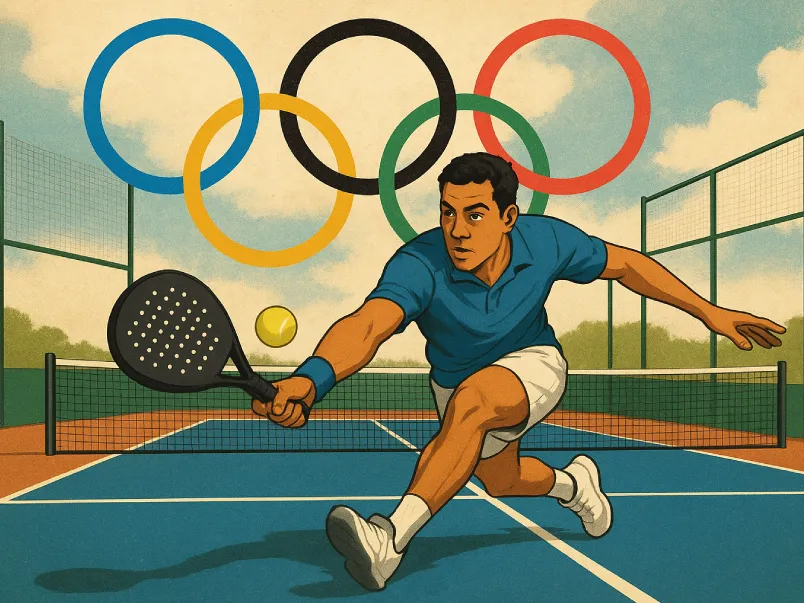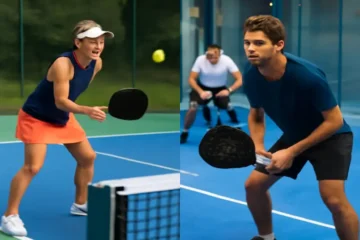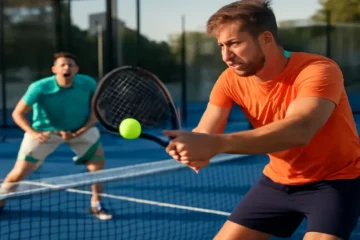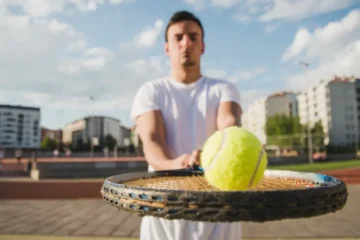The Meteoric Rise of a Sporting Phenomenon
In recent years, a lesser-known sport has been taking the world by storm. Padel, a dynamic and accessible mix of tennis and squash, has rapidly grown in popularity, with millions now playing in over 90 countries. Once primarily associated with Spain and Argentina, the sport is now thriving in new territories across Europe, North America, and Asia. What started as a niche pastime has swiftly become one of the fastest-growing sports worldwide. From packed local courts to international competitions, padel’s appeal is undeniable.
As the sport continues its upward trajectory, a central question arises: With its explosive growth and a steadily increasing global fanbase, is padel on track to make its debut at the Olympic Games? While the answer remains uncertain, there is a growing sense that the sport could soon be a fixture in Olympic competitions. However, before padel can join the ranks of elite Olympic sports, there are several hurdles that need to be overcome.
This article explores the factors that position padel as a strong Olympic contender and examines the roadblocks it must navigate to achieve its Olympic dream.
II. The Case For: Why Padel is a Strong Olympic Contender
A. Unprecedented Global Growth
One of the most compelling reasons padel is becoming a serious contender for Olympic inclusion is its unparalleled global growth. Originally popular in Spain and Argentina, the sport has expanded rapidly to countries across Europe, including Sweden, Italy, and the United Kingdom. In recent years, North America has witnessed a surge in padel’s popularity, especially in the United States, where major sports organizations are beginning to recognize the sport’s potential.
According to the International Padel Federation (FIP), the number of padel courts worldwide has skyrocketed from just over 3,000 in 2010 to more than 20,000 today. Participation rates are also soaring, with millions of players engaging in the sport across the globe. These numbers are a testament to padel’s expanding reach and growing fanbase.
The sport’s expansion isn’t just limited to the traditional strongholds of Europe and Latin America. Asia, particularly the Middle East, is seeing a rise in padel participation. In Dubai and Qatar, new, state-of-the-art padel facilities are opening, attracting a diverse mix of international players. This worldwide growth places padel in the same league as other Olympic sports in terms of global engagement and reach.
B. Inherent Appeal and Accessibility
Padel’s simplicity and accessibility make it an appealing sport for people of all ages and skill levels. The game is relatively easy to pick up, especially for those familiar with tennis or squash. With its smaller court size, padel allows players to enjoy the game without needing the same physical endurance required in traditional tennis, making it more inclusive and approachable for newcomers.
Unlike tennis, which is often seen as a more individualistic sport, padel is typically played in doubles, fostering a sense of community and social interaction. This social aspect is one of the main reasons why the sport is so appealing to recreational players and families alike. Additionally, its fast-paced nature makes it exciting to watch, which bodes well for attracting larger audiences, a critical factor for any sport hoping to secure a place in the Olympics.
C. Strong and Organized Governing Body
Another crucial factor in padel’s Olympic aspirations is the existence of a well-established and organized governing body: the International Padel Federation (FIP). The FIP plays an essential role in standardizing the rules of the game and promoting the sport globally. With over 30 member countries, the FIP has created a network of national federations that helps padel grow in new regions and maintain a consistent standard of play across borders.
Additionally, the professional circuit of padel is thriving, with two major tours: the World Padel Tour and Premier Padel. These tours showcase the best players in the world and attract significant media attention, further boosting the sport’s visibility. A professional circuit, coupled with an organized governing body, lays the groundwork for Olympic inclusion by demonstrating the sport’s global appeal and commitment to maintaining high standards of competition.
D. Television and Commercial Viability
Padel’s increasing popularity has caught the attention of major broadcasters and sponsors. In recent years, television deals and streaming services have allowed padel events to be broadcast to a growing global audience. The sport’s appeal to a young, active demographic has made it a prime target for companies seeking to align themselves with an emerging, dynamic market. These commercial partnerships are vital for any sport seeking Olympic inclusion, as the International Olympic Committee (IOC) often looks for sports that have strong media and sponsorship potential.
With padel’s increasing visibility and potential for attracting lucrative deals, it is poised to continue its rise in the sporting world. This makes it an attractive option for Olympic organizers looking to tap into new audiences and secure new revenue streams.
III. The Hurdles: The Roadblocks to Olympic Inclusion
Despite the compelling case for padel, there are several challenges that the sport must overcome before it can be included in the Olympic Games.
A. The Strict Criteria of the IOC
One of the most significant obstacles padel faces in its quest for Olympic inclusion is the strict criteria set by the International Olympic Committee. According to Olympic Charter Rule 45, in order to be considered for inclusion, a sport must be “widely practiced by men in at least 75 countries and on four continents, and by women in no fewer than 40 countries and on three continents.”
While padel has experienced impressive growth, it is still working to meet these thresholds. The sport is growing rapidly, but it has yet to achieve widespread participation in some regions, particularly in Africa and parts of Asia. The IOC’s standards are designed to ensure that the Olympic Games represent sports that have truly global appeal, so padel will need to continue its expansion into new markets to meet these requirements.
B. Competition for Limited Spots
The IOC’s decision to include new sports in the Games is a highly competitive process. As the number of events in the Olympic program is limited, there is fierce competition among sports hoping to be added. For example, in recent years, sports like squash, breakdancing, and flag football have all fought for a spot in the Games.
Furthermore, the IOC is placing increasing emphasis on gender equality and youth engagement, which means that sports must show progress in these areas to be considered. While padel is played by both men and women, and it has seen growth in female participation, it will need to demonstrate more widespread gender equity in order to stand out among other candidates.
C. The “One-In, One-Out” Mentality and Program Saturation
The IOC has increasingly embraced a “one-in, one-out” approach to its Olympic program. This means that the addition of a new sport often results in the removal of an existing one. Recent examples include the inclusion of skateboarding and surfing for the 2024 Paris Olympics, while other sports, such as baseball/softball, were removed to make space.
The IOC’s limited space for new sports means that padel may face competition from established Olympic sports fighting to keep their place. For padel to overcome this barrier, it will need to convince the IOC that it offers something fresh and valuable to the Olympic Games, justifying its inclusion while avoiding displacing other sports.
IV. The Current Status and Timeline: Where Does Padel Stand?
A. Official Recognition: The First Major Step
In 2023, padel took a significant step toward its Olympic dream when it was officially recognized by the International Olympic Committee (IOC). This recognition does not guarantee Olympic inclusion, but it opens the door for padel to receive funding and participate in IOC events. It is an important milestone in the journey toward full Olympic status.
This recognition means that padel is now eligible for funding and can be included in future IOC activities. However, it still needs to clear significant hurdles, including meeting participation thresholds and gaining support from both the IOC and host cities.
B. The Pathway to the Games: What’s Next?
The next step for padel is to continue gaining recognition by participating in multi-sport events like the European Games, Pan American Games, and Asian Games. These events offer a platform for padel to showcase its appeal and organizational strength while helping to meet the IOC’s criteria for global participation.
Additionally, the lobbying process will play a crucial role in padel’s Olympic future. National federations and the FIP will need to work together to present a compelling case for padel to be included in the Olympic program, including lobbying future Olympic host cities and demonstrating the sport’s broad appeal to a global audience.
C. Realistic Timelines: Which Olympics are a Possibility?
Given the current trajectory, the 2028 Los Angeles Olympics may be too soon for padel to secure a spot. However, the 2032 Brisbane Olympics or even the 2036 Games could provide a more realistic timeline. By then, padel is expected to have solidified its global presence, met the IOC’s participation requirements, and continued to build its case for Olympic inclusion.
V. Conclusion: Not If, But When?
Padel’s journey toward the Olympic Games is filled with promise, but it is not without challenges. The sport’s rapid growth, accessibility, and commercial appeal make it a strong contender, while the organizational backing of the FIP adds credibility to its Olympic aspirations. However, padel must overcome hurdles such as meeting IOC criteria, navigating competition for limited spots, and addressing the “one-in, one-out” mentality of the Olympic program.
Despite these obstacles, padel’s momentum is undeniable. The global community of players, fans, and industry stakeholders is laying a solid foundation for the sport’s future. The question is no longer “if” padel will become an Olympic sport, but “when.” With continued growth and effort, the Olympic dream for padel could soon become a reality, capturing the hearts of millions around the world as it joins the ranks of elite sports in the Olympic Games.
FAQs:
1. What is padel?
Padel is a racquet sport combining elements of tennis and squash. Played on a smaller court with walls, it is typically played in doubles. It is known for its accessibility and social nature, making it appealing to players of all ages and skill levels.
2. Is padel going to be included in the Olympics?
While padel has gained significant global popularity and has been officially recognized by the International Olympic Committee (IOC), it has not yet been added to the Olympic program. However, its rapid growth and strong case make it a strong contender for future Olympic inclusion.
3. What are the key factors pushing padel toward the Olympics?
Padel’s rapid global growth, increasing participation, organized professional circuits, and broad appeal to all ages and skill levels are some of the main factors. Additionally, the sport’s rising commercial potential and media visibility are key to its Olympic aspirations.
4. What challenges does padel face in becoming an Olympic sport?
Padel faces several hurdles, including meeting the IOC’s strict criteria for global participation, competition from other sports vying for Olympic spots, and the challenges posed by the IOC’s “one-in, one-out” policy regarding the Olympic program.
5. When could padel become an Olympic sport?
Padel has made significant strides, and while it may be too soon for the 2028 Los Angeles Games, the 2032 Brisbane Olympics or 2036 could be realistic targets, provided the sport continues to grow and meets all required thresholds.
6. How popular is padel worldwide?
Padel is one of the fastest-growing sports worldwide. There are currently over 20,000 courts in over 90 countries, and participation is increasing steadily, especially in Europe, North America, and parts of Asia and the Middle East.
7. Who governs the sport of padel?
The International Padel Federation (FIP) is the global governing body responsible for standardizing the rules, organizing events, and promoting padel worldwide. The FIP plays a crucial role in lobbying for padel’s inclusion in the Olympics.




